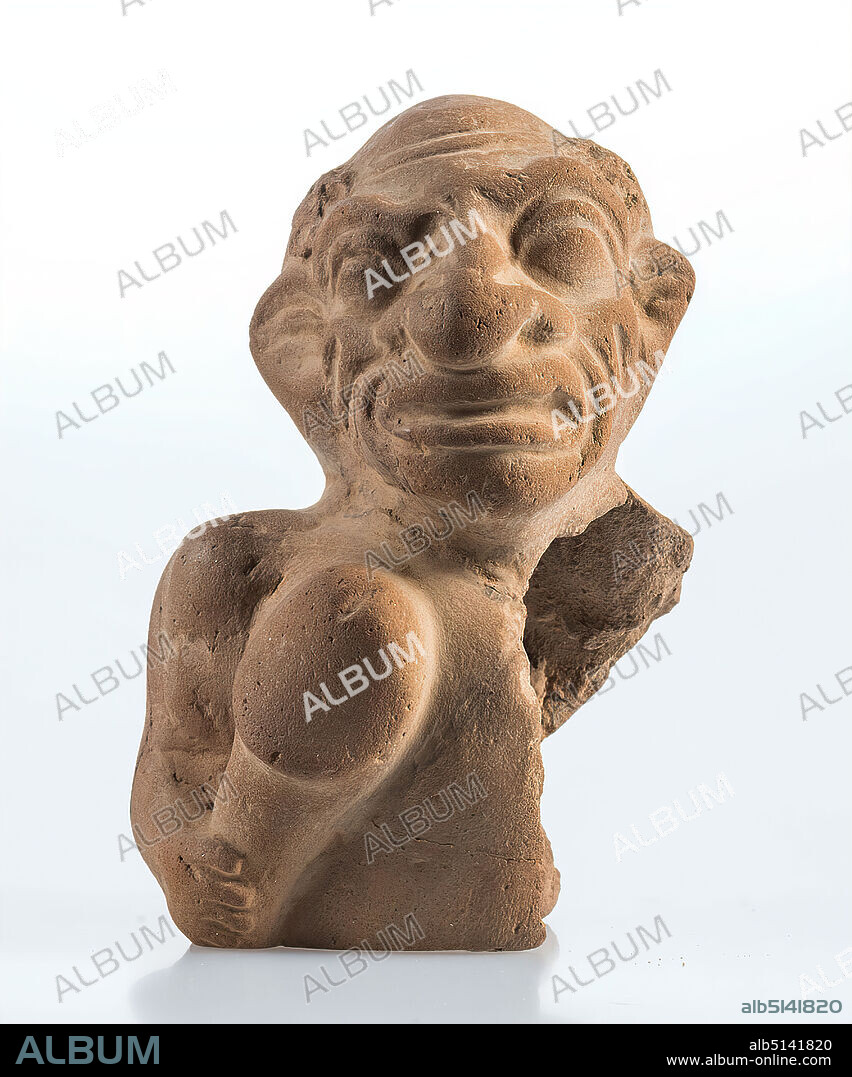alb5141820
Grotesque Man, clay, pressed into shape, hand modeled, fired (ceramic), clay, Total: Height: 10.2 cm; Width: 6.8 cm; Depth: 7.6 cm, ceramic, slavery; Slaves, penis, phallus, types of people, Hellenism, Early Imperial Period, Middle Imperial Period, The fragment of a Fayum terracotta with eyelet attached at the back shows the head and parts of the upper body of a man. It shows the typical tortured face of slaves or underclass; prominent features are the broad hooked nose, deep forehead and cheek wrinkles, thick lips and covered brow arches. The eyes are sharply contoured. A hair-wreath is indicated. A large phallus is clamped under the right arm. Lower body and the left side of the upper body are not preserved. The figure belongs to the group of the so-called Fayum terracottas. In Alexandria, the international, Greek-influenced center of Egypt, lives a multicultural society of Egyptians, Orientals, Greeks, Romans, Jews and others, whose different religious ideas are gradually blending together. Insights into this world of faith are provided by the so-called Fayum terracottas. They are part of the religious household, children's toys, knick-knacks, but also cult symbols, grave goods, pilgrimage images, votive offerings and magical objects for banishing evil forces. They can be found in houses, graves and sanctuaries.

|
Add to another lightbox |
|
Add to another lightbox |



Caption:
Grotesque Man, clay, pressed into shape, hand modeled, fired (ceramic), clay, Total: Height: 10.2 cm; Width: 6.8 cm; Depth: 7.6 cm, ceramic, slavery; Slaves, penis, phallus, types of people, Hellenism, Early Imperial Period, Middle Imperial Period, The fragment of a Fayum terracotta with eyelet attached at the back shows the head and parts of the upper body of a man. It shows the typical tortured face of slaves or underclass; prominent features are the broad hooked nose, deep forehead and cheek wrinkles, thick lips and covered brow arches. The eyes are sharply contoured. A hair-wreath is indicated. A large phallus is clamped under the right arm. Lower body and the left side of the upper body are not preserved. The figure belongs to the group of the so-called Fayum terracottas. In Alexandria, the international, Greek-influenced center of Egypt, lives a multicultural society of Egyptians, Orientals, Greeks, Romans, Jews and others, whose different religious ideas are gradually blending together. Insights into this world of faith are provided by the so-called Fayum terracottas. They are part of the religious household, children's toys, knick-knacks, but also cult symbols, grave goods, pilgrimage images, votive offerings and magical objects for banishing evil forces. They can be found in houses, graves and sanctuaries.
Personalities:
Credit:
Album / quintlox
Releases:
Model: No - Property: No
Rights questions?
Rights questions?
Image size:
3596 x 4320 px | 44.4 MB
Print size:
30.4 x 36.6 cm | 12.0 x 14.4 in (300 dpi)
Keywords:
ALEXANDRIA • ANATOMY: HEAD • BACK • BANISHING EVIL FORCES • BELIEF • BROAD HOOKED NOSE • CERAMIC • CHEEK WRINKLES • CHILDREN'S TOYS • CLAMPED UNDER • CLAY • COVERED BROW ARCHES • CULT SYMBOLS • DECOR • DECORATION • DECORATIONS • DECORATIVE • DEEP FOREHEAD • DEPTH • DIFFERENT RELIGIOUS IDEAS • EARLY IMPERIAL PERIOD • EGYPT • EGYPTIAN • EGYPTIANS • EYE • EYEBALLS • EYELET ATTACHED • EYES • FAITH • FAYUM TERRACOTTA • FAYUM TERRACOTTAS • FIGURE BELONGS • FIRED • FORMS (GEOMETRIC) • FRAGMENT • GRADUALLY BLENDING TOGETHER • GRAVE GOODS • GRAVES • GREEK-INFLUENCED CENTER • GREEKS • GROTESQUE MAN • GROUP • HAIR-WREATH • HAND MODELED • HEAD (ANATOMY) • HEAD (BODY) • HEAD • HELLENISM • HOUSE • HOUSES • HUMANS • INDICATED • INSIGHTS • INTERNATIONAL • JEW • JEWISH • KERAMEIKOS • LARGE PHALLUS • LEFT SIDE • LIVES • LOWER BODY • MAGICAL OBJECTS • MAN • MEN • MIDDLE IMPERIAL PERIOD • MULTICULTURAL SOCIETY • ORIENTALS • ORNAMENT • ORNAMENTATION • ORNAMENTS • PART • PARTS • PENE • PENILE • PENIS • PEOPLE • PHALLUS • PILGRIMAGE IMAGES • POTTERIES • PRESERVED • PRESSED • PROMINENT FEATURES • PROVIDED • RELIGION • RELIGIOUS HOUSEHOLD • RELIGIOUS • RIGHT ARM • ROMANS • SANCTUARIES • SHAPE • SHARPLY CONTOURED • SLAVERY • SLAVES • STONEWARE • TERRA COTTA • TERRACOTA • TERRACOTTA • THE • THICK LIPS • TYPES • TYPICAL TORTURED FACE • UNDERCLASS • UPPER BODY • VOTIVE OFFERINGS • WORLD
 Pinterest
Pinterest Twitter
Twitter Facebook
Facebook Copy link
Copy link Email
Email
